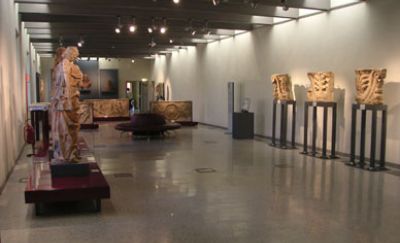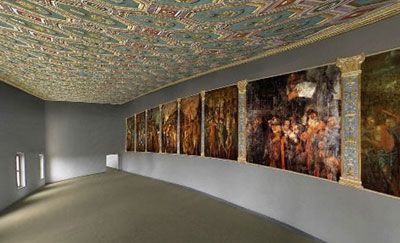The large room on the first floor of the palazzo unfortunately conserves no traces of the original decoration, which we know to have been particularly rich and sumptuous. The room is striking for its size alone, however. Francesco II Gonzaga specifically commissioned the vast hall to accommodate all the nine large canvases of the Triumphs of Caesar by Mantegna, jewel in the crown of the Gonzaga art collections. The paintings were displayed in groups of three on the south wall, and were hung about two and a half metres off the floor. As was customary at the time, the lower parts of the walls were panelled with wood, perhaps with seating as well.
On the short sides the decoration of the room, heavily influenced by Mantegna, as indeed was all the decoration in Palazzo San Sebastiano, was completed by two large paintings by Lorenzo Costa the Elder (1460-1535). The first, now lost, is described by Giorgio Vasari as representing a Sacrifice to Hercules, complete with portraits from life of Francesco II and his three sons, Federico, Ercole and Ferrante. The second painting, signed and dated 1522, is now in the National Gallery in Prague. It shows the appointment of Duke Federico II Gonzaga as commanding general of the papal forces. The room, originally over seven metres high (in the seventeenth century it was lowered to obtain a second floor) had a highly ornate ceiling with the motif of the crucible in gilded wood, now housed in Palazzo Ducale.
The vast hall was used for important dinners, celebrations or to honour distinguished guests. Here in 1585, in the presence of the entire court, St Aloysius Gonzaga formally renounced his right of primogeniture in favour of his brother Rodolfo.
The art displayed in the large Room of the Triumphs focuses the attention on Mantua during the Renaissance and the important architecture commissioned or patronized by the various princes of the Gonzaga family who gave the city its appearance: in particular Ludovico II, Francesco II and Federico II Gonzaga. All the works exhibited are from major historical buildings. These mark the principal stages of an imaginary route known as the “prince’s way”, which crosses the city from north to south, beginning and ending at the key residences of the Gonzaga: Palazzo Ducale to the north and Palazzo San Sebastiano and Palazzo Te to the south. Between these, the main buildings, public and private, stand as testimony to both economic and religious power. They also document the gradual development of Mantua during a truly princely era, fortunate enough to enjoy the work of artists including Andrea Mantegna, Leon Battista Alberti, Luca Fancelli and Giulio Romano. The first part of the route - with two tondos bearing Gonzaga devices, Virgil Enthroned and four capitals from the Basilica di Sant’ Andrea - refers conceptually to the north of the city, which was the centre of aristocratic and religious power, while the last group of works on display – the balustrades, modillion, pair of Gonzaga coats of arms and a hanging corbel - refer instead to the area to the south. However , "the Prince’s city" was a far more comprehensive concept, as exemplified here by the Ginori coat of arms from Palazzo del Podestà, the sculptures from Palazzo Valenti, and the busts of Virgil, Battista Spagnoli and Francesco Gonzaga from the Porta Nuova arch.





